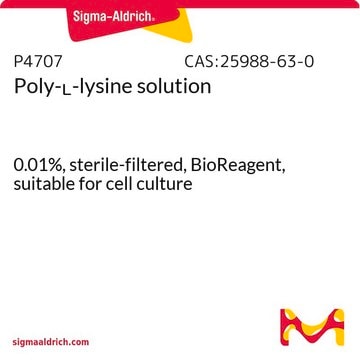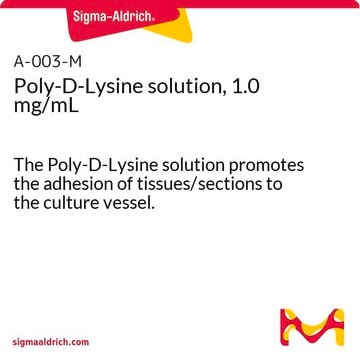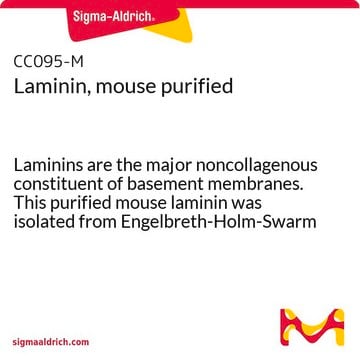Diluting the Poly-L-Ornithine solution in PBS to achieve the desired concentration is not recommended; instead, use sterile water as instructed. Please follow the provided guidelines carefully for optimal results. For more information, refer to: https://www.sigmaaldrich.com/en/product/mm/a004m
A-004-M
Poly-ʟ-Ornithine
synthetic, liquid, 0.1 mg/mL, suitable for cell culture
Sinônimo(s):
Poly-L-Ornithine Solution (0.01%), A-004-M, Sigma-Aldrich
About This Item
Produtos recomendados
Nome do produto
Poly-L-Ornithine Solution (0.01%),
fonte biológica
synthetic
Nível de qualidade
tamanho da agulha
2.0 mm
esterilidade
sterile
Formulário
liquid
peso molecular
Mw 78000 Da
fabricante/nome comercial
NovaSeptum®
concentração
0.01 % (w/v)
0.1 mg/mL
técnica(s)
cell attachment: suitable
cell culture | mammalian: suitable
Categorias relacionadas
Descrição geral
Research Sub Category: Adhesion (CAMs)
Aplicação
- glass-bottom plates for cell plating in a research study investigating the localization of cMET in MDA-MB-468 cells using confocal microscopy[1]
- culture dishes for adult human neural stem cells (ahNSCs) primary culture[2]
- 6-well plates for induced pluripotent stem cells (iPSCs) culture and neuronal differentiation[3]
Qualidade
forma física
Nota de preparo
2. Dilute Poly-L-Ornithine solution to the desired concentration in sterile water.
3. Fully coat the cell culture surface with diluted Poly-L-Ornithine solution. Use 5 mL volume for 6-cm plates and 10 mL volume for 10-cm plates and T75 flasks.
4. Allow the cell culture vessel to sit at room temperature overnight.
5. Aspirate the Poly-L-Ornithine solution the following day and rinse the vessel with sterile water followed by coating with desired ECM protein. Optimal coating concentrations must be determined by the end user. Typical coating concentrations range from 10ug/ml to 100ug/ml based on cell type and application.
Armazenamento e estabilidade
Informações legais
Exoneração de responsabilidade
Código de classe de armazenamento
12 - Non Combustible Liquids
Classe de risco de água (WGK)
WGK 1
Ponto de fulgor (°F)
Not applicable
Ponto de fulgor (°C)
Not applicable
Certificados de análise (COA)
Busque Certificados de análise (COA) digitando o Número do Lote do produto. Os números de lote e remessa podem ser encontrados no rótulo de um produto após a palavra “Lot” ou “Batch”.
Já possui este produto?
Encontre a documentação dos produtos que você adquiriu recentemente na biblioteca de documentos.
Os clientes também visualizaram
Artigos
Discover L-ornithine, an important amino acid supplement, explore how L-ornithine is used in CHO and iPSC culture, and discover how poly-L-ornithine is used to enhance cell attachment.
-
Could I dilute Poly-L-Ornithine solution (A-004-C) to the desired concentration in PBS rather then sterile water?
1 answer-
Helpful?
-
Active Filters
Nossa equipe de cientistas tem experiência em todas as áreas de pesquisa, incluindo Life Sciences, ciência de materiais, síntese química, cromatografia, química analítica e muitas outras.
Entre em contato com a assistência técnica












